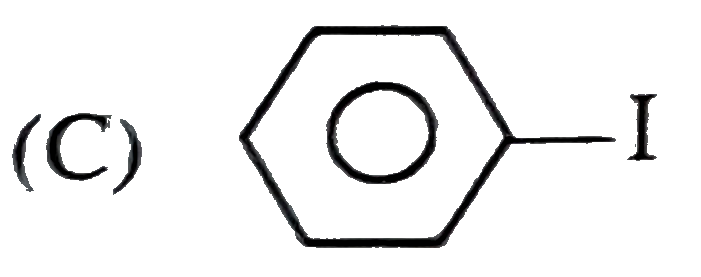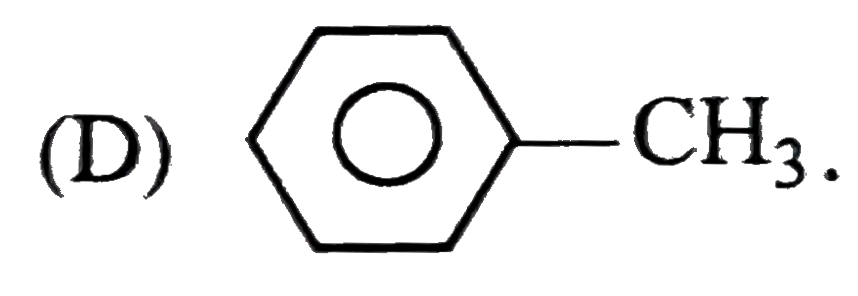In the reaction , C2H5Br(i)Li−−−−→(ii)CuI(X)CH3Br−−−→(Y), the products X and Y are ________ and ____________ respectively.
The correct Answer is:(C2H5)2CuLi,CH3C2H5
To solve the problem, we need to analyze the given reaction step by step.
Step 1: Identify the starting compound
The starting compound is C2H5Br (ethyl bromide).
Step 2: Reaction with Lithium
When C2H5Br reacts with lithium (Li), it forms an organolithium compound. The reaction can be represented as:
\( C2H5Br + Li \rightarrow C2H5Li + LiBr \)
Here, C2H5Li is the organolithium compound formed, and LiBr is a byproduct.
Step 3: Reaction with Copper(I) Iodide
Next, the organolithium compound C2H5Li reacts with copper(I) iodide (CuI). The reaction can be represented as:
\( C2H5Li + CuI \rightarrow C2H5Cu + LiI \)
In this step, we form an organocopper compound, C2H5Cu, and lithium iodide (LiI) is formed as a byproduct.
Step 4: Reaction with Methyl Bromide
Now, we take the organocopper compound C2H5Cu and react it with methyl bromide (CH3Br). The reaction can be represented as:
\( C2H5Cu + CH3Br \rightarrow C2H5CH3 + CuBr \)
In this step, we form the final product C2H5CH3 (which is butane) and copper(I) bromide (CuBr) as a byproduct.
Conclusion
From the above steps, we can conclude that:
- The product \( X \) is C2H5Cu (the organocopper compound).
- The product \( Y \) is C2H5CH3 (butane).
Thus, the products \( X \) and \( Y \) are C2H5Cu and C2H5CH3 respectively.
Final Answer
The products \( X \) and \( Y \) are C2H5Cu and C2H5CH3 respectively.
---
The starting compound is C2H5Br (ethyl bromide).
When C2H5Br reacts with lithium (Li), it forms an organolithium compound. The reaction can be represented as:
\( C2H5Br + Li \rightarrow C2H5Li + LiBr \)
Here, C2H5Li is the organolithium compound formed, and LiBr is a byproduct.
Next, the organolithium compound C2H5Li reacts with copper(I) iodide (CuI). The reaction can be represented as:
\( C2H5Li + CuI \rightarrow C2H5Cu + LiI \)
In this step, we form an organocopper compound, C2H5Cu, and lithium iodide (LiI) is formed as a byproduct.
Now, we take the organocopper compound C2H5Cu and react it with methyl bromide (CH3Br). The reaction can be represented as:
\( C2H5Cu + CH3Br \rightarrow C2H5CH3 + CuBr \)
In this step, we form the final product C2H5CH3 (which is butane) and copper(I) bromide (CuBr) as a byproduct.
From the above steps, we can conclude that:
- The product \( X \) is C2H5Cu (the organocopper compound).
- The product \( Y \) is C2H5CH3 (butane).
The products \( X \) and \( Y \) are C2H5Cu and C2H5CH3 respectively.
Topper's Solved these Questions
- HYDROCARBONSBOOK - PRADEEPCHAPTER - HYDROCARBONSEXERCISE - CONCEPTUAL Questions
28 Videos
- HYDROCARBONSBOOK - PRADEEPCHAPTER - HYDROCARBONSEXERCISE - NCERT QUESTION AND EXERCISES WITH ANSWERS
14 Videos
- HYDROCARBONSBOOK - PRADEEPCHAPTER - HYDROCARBONSEXERCISE - TEST YOUR GRIP (MULTIPLE CHOICE )
26 Videos
- EQUILIBRIUM IN PHYSICAL AND CHEMICAL PROCESSESBOOK - PRADEEPCHAPTER - EQUILIBRIUM IN PHYSICAL AND CHEMICAL PROCESSESEXERCISE - Competition Focus (Jee(Main and advanced)/Medical Entrance) VIII. ASSERTION - REASON TYPE QUESTIONS (TYPE - II)
10 Videos
- HYDROGEN BOOK - PRADEEPCHAPTER - HYDROGEN EXERCISE - COMPETITION FOCUS (Assertion-Reason Type Questions) Type 2
15 Videos
Similar Questions
Knowledge Check
In the following reaction , C6H5CH2Br1.Mg,Ether−−−−−−−→2.H3O+X,
the product 'X' isAC6H5CH2OCH2C6H5BC6H5CH2OHCC6H5CH3DC6H5CH2CH2C6H5In the following reaction,
C6H5CH2Br(i) Mg, ether−−−−−−−−→(ii)H3O+X,
the product 'X' isAC6H5CH2OCH2C6H5BC6H5CH2OHCC6H5CH3DC6H5CH2CH2C6H5C6H5BrMg−−→XCH3I−−→Y
The product Y isA B
B C
C D
D
In the reaction
H−C≡CH(1)NaNH2/liq.NH3−−−−−−−−−−−−−→(2)CH3CH2BrX(1)NaNH2/liq.NH3−−−−−−−−−−−−−→(2)CH3CH2BrY
X and Y are
View SolutionIn the reaction,
H−C≡CH(i)NaNH2/liq.NH3−−−−−−−−−−−−−→(ii)CH3CH2BrX(i)NaNH2/liq.NH3−−−−−−−−−−−−−→(ii)CH3CH2BrY,
X and Y are
View SolutionIn the following reaction sequence,
C6H5BrCuCN/pyridine−−−−−−−−−→523KXdil.H2SO4−−−−−−→boilY
the product Y is
View SolutionIn the reaction C3H6+X(C6H5CO)2O2−−−−−−−−−→CH3−C∣CH2BrH2 , 'X' is -
View SolutionIn the following sequence of reactions:
C2H5BrAgCN−−−→XReduction−−−−−→Y, Y is:
View Solution
